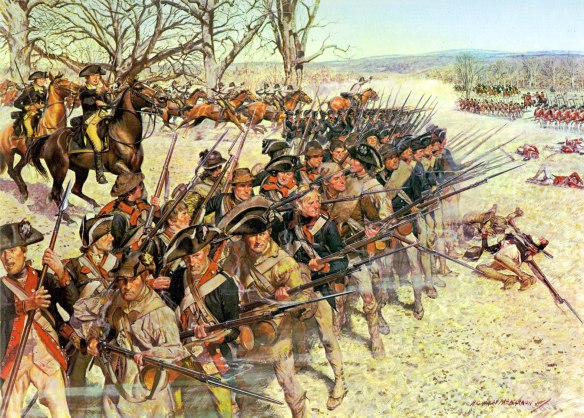Victory in defeat. In 1781, Greene’s force of 4,400 Continentals and militia took on the advancing Cornwallis at Guilford Court House, North Carolina. The British had only 1,900 men, but most were seasoned regulars. The battle was bitter, with furious hand-to-hand fighting. Cornwallis held the field but suffered more than 500 casualties. Greene lost fewer—78 were killed and 183 wounded.
Storming the Yorktown redoubt. Washington moved his trenches and artillery steadily closer to the British fortifications by digging new works under cover of darkness. Cornwallis was forced into an ever-smaller defensive position. On October 14th, Captain Alexander Hamilton led a night-time assault against a British redoubt, while French infantry attacked another. When the cannon captured in those redoubts were turned on Yorktown, Cornwallis had no choice but surrender.
On June 14, 1775, the Second Continental Congress voted to raise a Continental Army that would provide for the security of the colonists and bolster the forces already gathering in defense of New England. The Continental Army illustrated both the promise and the limitations of a revolutionary military force facing the professional soldiers of an imperial army.
Congress sought a regular force of 75,000 soldiers, but at its height the Continental Army had only 18,000 men. Recruits were to be paid, and the first ones came from the lower classes of Pennsylvania, Maryland, and Virginia. Because the British standing army that had been stationed in the colonies had been portrayed as a symbol of tyranny and corruption, many of the colonists were reluctant to raise a standing army of their own.
To command this new force, the Congress unanimously chose Gen. George Washington. Washington became commander ‘of all the Continental forces, raised or to be raised, for the defense of American liberty.’ Washington was widely considered a military genius, but the fact that he was from Virginia, the largest and wealthiest colony, was also important. To fund Washington¡¦s force, Congress issued 2 million pounds of paper currency.
The Continental Army’s first test came at the Battle of Bunker Hill, where, on June 17, 1775, 1,200 Continental Army regulars resisted the frontal attack of 2,200 British soldiers. By the time the American sharpshooters ran out of ammunition and were forced to retreat, they had killed 1,054 men. Although the Continental Army did not win the battle, it scored a victory of sorts by demonstrating that it would fight fiercely and that the British recapture of the American colonies would be no easy task. News of the battle inspired patriots throughout the colonies.
Soldiers in the Continental Army signed up for one-year terms. This proved a worrisome problem for Washington, who saw the dissolution of his army as a greater threat than defeat by the British. He wrote, ‘You may as well attempt to stop the winds from blowing or the sun in its diurnal as the regiments from going home when their terms expire.’ The coming term expirations inspired Washington’s bold decision to cross the icy Delaware on Christmas night, 1776, to invade Trenton. Having lost at Newport, Rhode Island, and been driven out of New York, the army’s morale was very low. But the victories at Trenton and then Princeton turned the tide for the Americans.
Problems of insufficient supplies and irregular pay also plagued the Continental Army. Such low points as the winter of 1777-1778 at Valley Forge nearly led to mutiny. By 1783, however, the war was won and the peace settled, and the soldiers were discharged and sent home.
